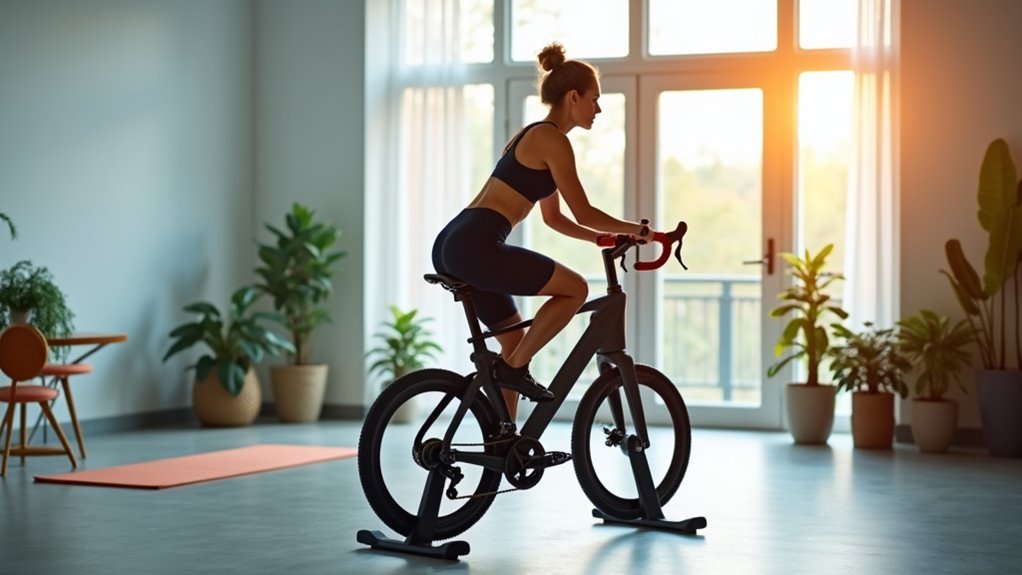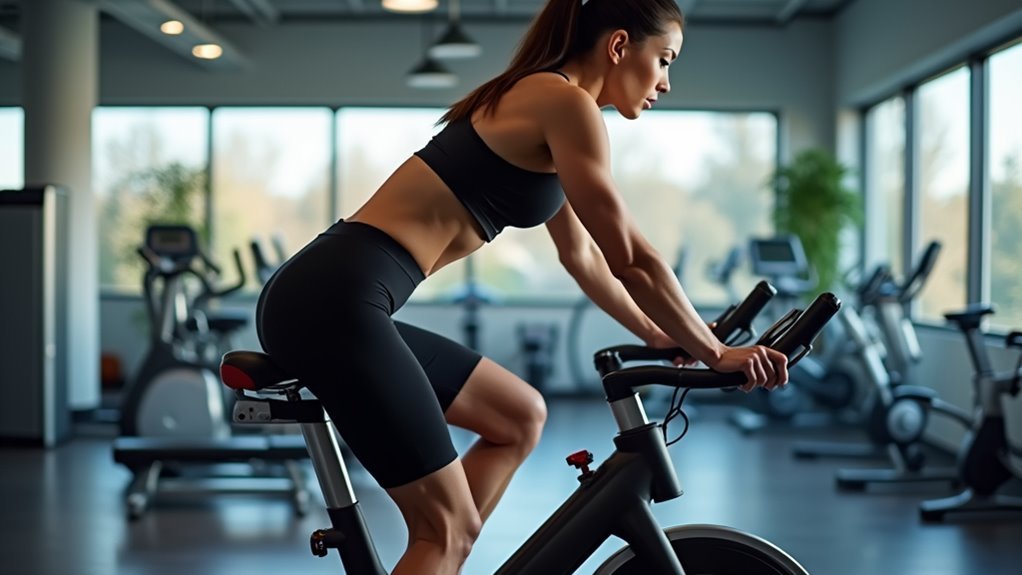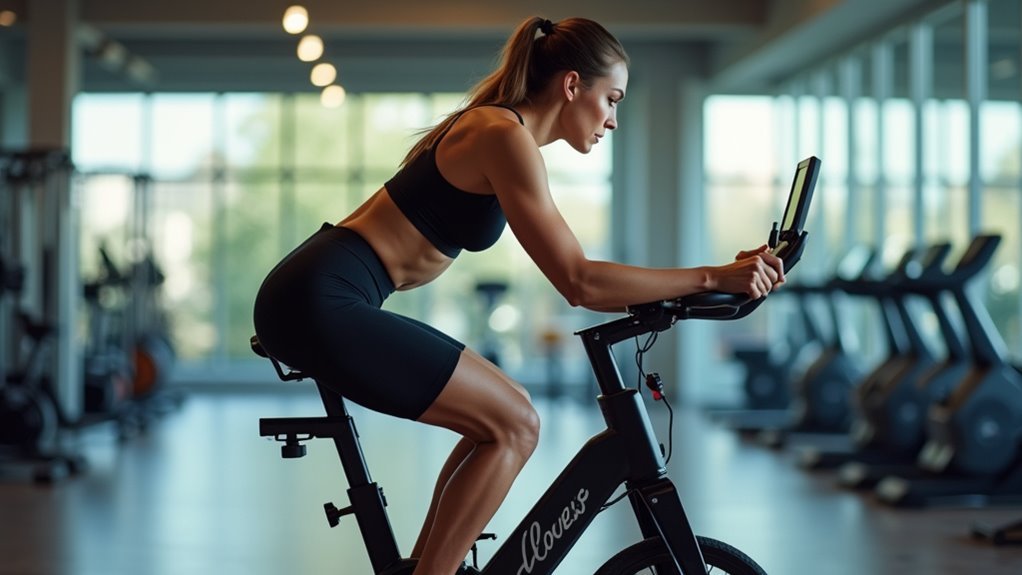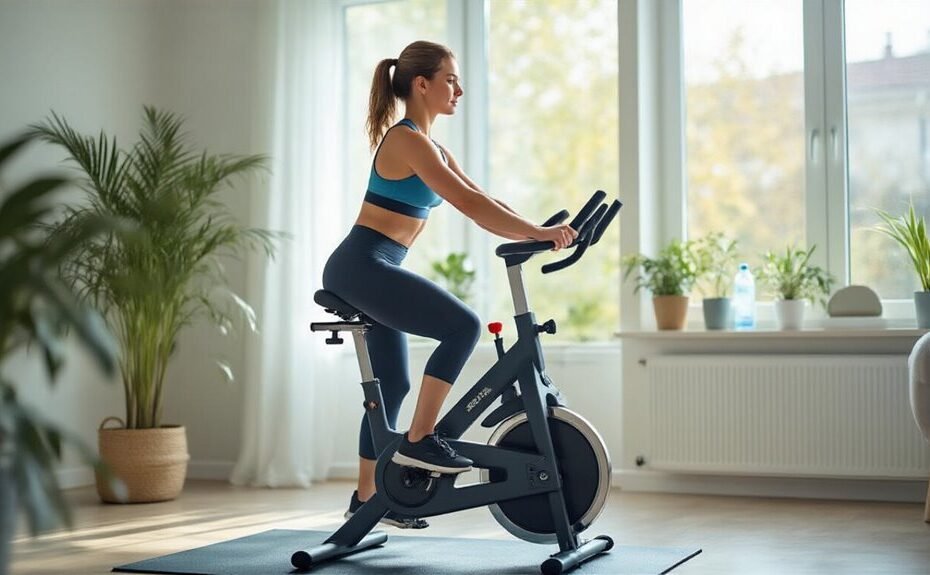Improper posture on an exercise bike is a common culprit behind workout pain. Many cyclists endure unnecessary discomfort because they’ve never learned proper alignment techniques. It’s actually pretty simple to fix once you know what to look for. The right adjustments to seat height, handlebar position, and pedaling form can transform an uncomfortable experience into an efficient, pain-free session. But where should someone start when everything feels wrong?
The Optimal Seat Height for Spine Alignment
Nearly every cycling enthusiast has experienced that nagging lower back pain after a long ride, often the result of an improperly adjusted seat height.
Finding the best seat height isn’t just about comfort—it’s essential for proper posture and spine health. The ideal setting allows a slight knee bend at the bottom stroke while aligning hip bones with the saddle top.
This balance distributes weight evenly, preventing lower back strain during extended rides.
A quick starting point? Multiply your inseam by 0.883.
But don’t set it and forget it. As your fitness evolves, regularly reassess your position to maintain that perfect alignment that keeps pain at bay. Incorporating adjustable resistance levels can further enhance your cycling experience, allowing you to adapt your workout intensity as needed.
Forward-Back Positioning to Prevent Lower Back Strain
Many cyclists overlook the critical relationship between saddle position and lower back comfort, yet proper forward-back positioning is essential for preventing strain during extended rides.
The ideal saddle placement allows your knee to align directly over the pedal axle when in the 3 o’clock position, creating a biomechanically efficient posture that naturally engages your core muscles.
Maintaining this proper alignment while actively engaging your core muscles—think about slightly drawing your navel toward your spine without hunching—creates a stable foundation that protects your lower back during even the most intense cycling sessions. Additionally, ensuring that your saddle height and handlebar position are correctly adjusted further contributes to effective muscle engagement and form stability.
Saddle Position Matters
The subtle dance between your body and exercise bike begins with proper saddle positioning. Finding the ideal forward-back position creates harmony between your knees and pedals, preventing unnecessary lower back strain during intense cycling sessions.
A well-adjusted saddle positions your knee directly above the pedal at the 3 o’clock position. If it’s too far forward, you’ll probably lean excessively, stressing your back. Too far back? Well, your hip angle becomes awkward.
The key to good cycling posture is that neutral bike fit where everything aligns naturally.
Remember to reassess your saddle position occasionally—your body’s needs evolve with your riding style.
Core Engagement Technique
Activating your core muscles transforms ordinary cycling into a full-body exercise that shields your lower back from strain.
Proper cycling form requires a subtle forward tilt of the pelvis while maintaining a neutral spine position. This engagement creates a stable foundation from which to pedal effectively.
Riders often forget their elbows play a role too—keeping them slightly bent distributes weight more evenly and complements core engagement.
Back pain during cycling usually signals poor posture rather than fitness issues.
Off-bike strengthening exercises like planks build the foundation for better on-bike form.
Regular saddle adjustments guarantee your body maintains ideal alignment for pain-free riding.
Handlebar Setup for Reduced Upper Body Tension

Proper handlebar setup represents one of the most overlooked aspects of exercise bike comfort, yet it’s vital for preventing tension throughout your upper body.
The ideal handlebar position should allow for slightly bent elbows and neutral wrists, creating correct form without straining shoulders or back.
Riders should adjust handlebars to a height that feels natural—generally higher for those with existing back issues.
Upper body posture improves when there’s adequate knee clearance during pedaling.
Regularly reassessing your setup as your fitness changes guarantees continued comfort. Additionally, proper sizing ensures best power transfer and prevents discomfort during rides.
Core Engagement Techniques While Cycling
While proper handlebar positioning creates the foundation for good posture, core strength serves as the powerhouse behind effective cycling form.
On an exercise bike, activating these central muscles involves drawing the navel toward the spine while maintaining a neutral pelvis throughout pedal strokes.
Cyclists who neglect core engagement often experience lower back pain and premature fatigue. The ideal cycling position requires a delicate balance – slightly bent elbows, relaxed shoulders, and an activated midsection working in harmony.
Daily off-bike exercises like planks and bridges can dramatically improve on-bike stability. Furthermore, engaging your core during cycling not only enhances stability but also contributes to overall fitness by allowing for better energy transfer and endurance.
Think of your core as the bridge connecting upper and lower body – when it’s strong, power transfers more efficiently through your pedal stroke.
Proper Foot Placement and Pedaling Mechanics

Proper foot placement creates the foundation for effective pedaling mechanics, with the ball of your foot ideally positioned over the pedal axle to maximize power transfer.
Many cyclists overlook this essential alignment, which can lead to knee strain and reduced efficiency when riding for extended periods.
Adopting a smooth, circular pedaling motion rather than simply pushing downward not only engages more muscle groups but greatly reduces pressure points under the feet. Additionally, maintaining proper form during cycling can significantly enhance calorie burn and improve overall workout effectiveness.
Pedaling With Purpose
Mastering the art of pedaling transforms an ordinary exercise bike session into a targeted, joint-friendly workout. The pedal stroke should be smooth and circular—not choppy—maintaining a cadence between 80-100 RPM for ideal joint health and efficiency. This sweet spot depends on proper seat height and riding position, which together create the foundation for effective cycling.
| Pedaling Focus | Benefit | Implementation |
|---|---|---|
| Ball of Foot Placement | Maximizes Power | Center over pedal axle |
| Circular Motion | Reduces Joint Stress | Think “scraping mud” off shoe |
| Ideal Cadence | Prevents Knee Strain | Use lower gears when needed |
Foot-Pedal Connection Basics
The foot-pedal connection serves as the essential power transfer point in every cycling workout, yet many riders overlook this fundamental aspect of their form. Proper positioning involves aligning the ball of your foot directly over the pedal axle, creating an efficient energy transfer while reducing strain.
Maintaining a neutral position of the ankle distributes pressure evenly, preventing numbness during longer rides.
For peak performance, consider investing in stiffer-soled shoes and regularly checking cleat positioning. Too far forward might cause knee pain, while too far back strains the Achilles tendon.
These small adjustments can make a significant difference in comfort and power output.
Alignment Prevents Strain
Nearly every injury on an exercise bike can be traced back to one critical factor: alignment. Proper foot placement is the foundation of good bike setup, ensuring the ball of your foot aligns with the pedal spindle for efficient power transfer. This neutral position protects your Achilles tendon and foot nerves from unnecessary strain.
Maintaining a slight bend in your knees at the bottom of the pedal stroke prevents overextension, which can lead to lower back pain. It’s like building a house—if the foundation isn’t level, everything above it suffers.
Regularly reassess your positioning as your cycling form evolves to stay comfortable and injury-free.
Rest and Recovery Positions During Extended Workouts

During extended workouts on an exercise bike, properly timed rest and recovery positions can make the difference between a productive session and one that leaves you sore for days.
Incorporating these variations helps alleviate pressure on the lower back while enhancing your overall cycling experience.
- Stand up from the saddle every 10-15 minutes to promote circulation.
- Shift to a slightly reclined seated position to reduce spinal strain.
- Stretch hip flexors during brief breaks to prevent tightness.
- Take short recovery intervals that allow muscles to reset without cooling down.
These simple adjustments—when integrated thoughtfully—transform lengthy rides from potential pain triggers into sustainable exercise routines. Additionally, using a recumbent bike for its low-impact cardio benefits can further enhance your comfort during long sessions.
Frequently Asked Questions
What Is the 75 Rule in Cycling?
The 75 rule in cycling recommends maintaining heart rate at 75% of maximum during training. This sweet spot optimizes cycling benefits including enhanced endurance, fat oxidation, and overall performance optimization.
How to Ride a Stationary Bike Without Hurting Your Back?
Proper seat height with slight knee bend, correct handlebar positioning, and neutral spine posture prevent back strain. Core-strengthening exercises, proper pedal technique, and adequate back support maintain pain-free stationary cycling sessions.
Is 30 Minutes of Stationary Bike the Same as 30 Minutes of Walking?
Thirty minutes on a stationary bike offers similar cardiovascular benefits to walking but with different calorie burn differences. Stationary bike benefits include lower joint impact, while walking exercise comparison shows more weight-bearing activity.
What Is the Correct Posture for a Stationary Bike?
Correct stationary bike posture involves maintaining neutral spine alignment, proper bike seat height allowing slight knee bend, comfortable handlebar position for relaxed shoulders, and efficient pedal technique with knees aligned over pedals.
